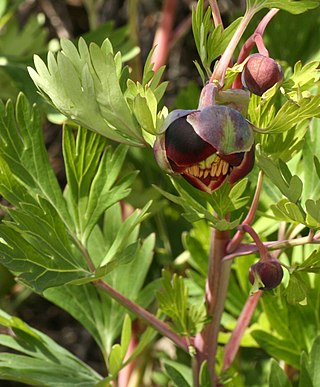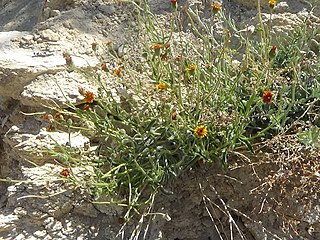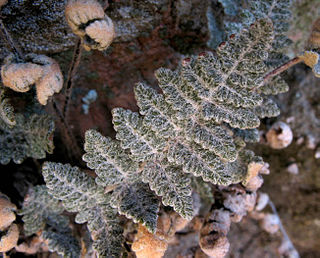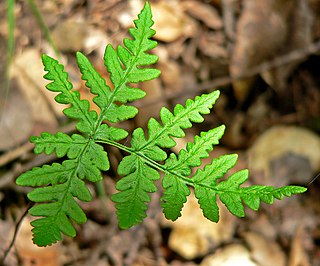
Vitis californica, with common names California wild grape, Northern California grape, and Pacific grape, is a wild grape species widespread across much of California as well as southwestern Oregon.

Notholaena, cloak fern, is a genus of ferns in the Cheilanthoideae subfamily of the Pteridaceae. Ferns of this genus are mostly epipetric or occurring in coarse, gravelly soils, and are most abundant and diverse in the mountain ranges of warm arid or semiarid regions. They typically have a creeping or erect rhizome and leaves that are pinnatifid to pinnate-pinnatifid with marginal sori protected by a false indusium formed from the reflexed margin of the leaf. Members of Notholaena also have a coating of whitish or yellowish farina on the surfaces of the leaves. The farina is often limited to the abaxial (lower) leaf surface, but may occur on the adaxial (upper) leaf surface as well. Members of the related Pentagramma genus have a similar lower leaf-surface farina.

Frangula californica is a species of flowering plant in the buckthorn family native to western North America. It produces edible fruits and seeds. It is commonly known as California coffeeberry and California buckthorn.

Paeonia californica is a perennial herbaceous plant of 35–70 cm high, that retreats underground in summer, and reoccurs with the arrival of the winter rains. It has lobed leaves, elliptic (cup-shaped) drooping flowers with dark maroon-colored petals, and many yellow anthers. It flowers mostly from January to March, and later develops two to five fruits per flower. Its common name is California peony and it is sometimes also referred to as wild peony. This peony is an endemic of southwestern California (USA), where it is not rare, and northernmost Baja California (Mexico). It grows on dry hillsides in the coastal sage scrub and chaparral communities of the coastal mountains of Southern and Central California, often as an understory plant.

Arctostaphylos glandulosa, with the common name Eastwood's manzanita, is a species of manzanita.

Hulsea vestita is a species of flowering plant in the family Asteraceae known by the common name pumice alpinegold.

Argyrochosma jonesii, known as Jones' false cloak fern, is a species of fern native to the southwestern United States and Sonora, Mexico. It grows on calcareous rocks, and has small, finely-divided leaves with a leathery texture and dark axes connecting the leaf segments. Unlike many members of Argyrochosma, it does not secrete white powder on the underside of its leaves. First described as a species in 1917, it was transferred to the new genus Argyrochosma in 1987, recognizing their distinctness from the "cloak ferns".

Myriopteris newberryi, formerly Cheilanthes newberryi, is a species of lip fern known by the common name Newberry's lip fern. It is native to southern California and Baja California.

Oenothera californica, known by the common name California evening primrose, is a species of flowering plant in the evening primrose family.

Orobanche californica, known by the common name California broomrape, is a species of broomrape. It is a parasitic plant growing attached to the roots of other plants, usually members of the Asteraceae.

Sidalcea malviflora is a species of flowering plant in the mallow family, known by the common names dwarf checkerbloom, Greek mallow, prairie mallow and dwarf checkermallow.

Pentagramma triangularis, commonly known as the gold fern or the goldback fern, is a species of fern in the family Pteridaceae, native to Western North America, with highest abundance in the state of California. Its common name "goldback" refers to the light yellow color of the fern's protective coating which inhibits moisture loss. The gold texture appears as a dry powder that is excreted on the underside of the fern. The Latin specific epithet Pentagramma derives from "five lines" or "stripes" while triangularis derives from "three sided", describing the shape of the fern's broad triangular fronds.

Notholaena standleyi, also known as star cloak fern and Standley's cloak fern, is a fern that is native to the United States and Mexico. It is a member of the genus Notholaena, which is part of the subfamily Cheilanthoideae of family Pteridaceae. It is distinguished by the pentagonal shape formed by the blades of its frond, a property other members of Notholaena do not possess.

Argyrochosma nivea is an Andean fern species in the family Pteridaceae.

Argyrochosma dealbata, the powdery false cloak fern, is a small fern endemic to the central and southern United States. It grows on calcareous rocks, such as limestone. Its leaves are highly divided, with leaf segments joined by shiny, chestnut-brown axes, and their undersides are coated with white powder, giving the fern its name. First described as a species in 1814, it was transferred to the new genus Argyrochosma in 1987, recognizing their distinctness from the "cloak ferns".

Argyrochosma peninsularis is a fern endemic to Baja California Sur. It grows in dry, rocky places. First described as a species in 1939, it was transferred to the new genus Argyrochosma in 1987, recognizing their distinctness from the "cloak ferns". A dusting of powdery material and the presence of occasional scales on the central axis of its leaves help distinguish it from related species.
Argyrochosma incana, the hairy false cloak fern, is a fern known from the southwestern United States through Mexico to Guatemala, and from a disjunct population in the Dominican Republic. It grows on rocky slopes and steep banks, often in forests. Like many of the false cloak ferns, it bears white powder on the underside of its leaves. First described as a species in 1825, it was transferred to the new genus Argyrochosma in 1987, recognizing their distinctness from the "cloak ferns".

Argyrochosma formosa is a fern known from eastern and central Mexico and Guatemala. It grows on rocky slopes, particularly on limestone. Unlike many members of the genus, it lacks white powder on the underside of its leaves. First described as a species in 1842, it was transferred to the new genus Argyrochosma in 1987, recognizing their distinctness from the "cloak ferns".

Argyrochosma limitanea, the southwestern false cloak fern, is a species of fern native to the southwestern United States and Sonora, Mexico. It grows on calcareous rocks, and has small, finely-divided leaves with a leathery texture, dark axes connecting the leaf segments, and a heavy coating of white powder on the undersurface. It reproduces apogamously; two subspecies are recognized, which may have originated independently through the hybridization of other taxa not yet discovered. First described as a species in 1919, it was transferred to the new genus Argyrochosma in 1987, recognizing their distinctness from the "cloak ferns".

Argyrochosma microphylla, the small-leaf false cloak fern, is a species of fern native to New Mexico, Texas and northern Mexico. It grows on limestone rocks and cliffs, and has finely-divided leaves with small leaf segments, often folded in half when dry, which lack the white powder present on the leaf underside of many related species. First described as a species in 1869, it was transferred to the new genus Argyrochosma in 1987, recognizing their distinctness from the "cloak ferns".



















